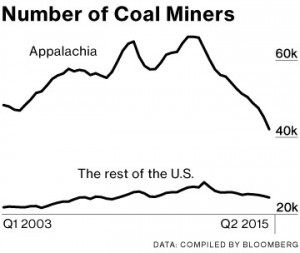Tax Dollars Follow Coal Out of Appalachia
< < Go Back
Mine closures leave towns struggling to keep public services running.
In Kentucky’s Letcher County, emergency response time for sheriff’s deputies averages an hour, up from 30 minutes a year ago. Martin County, also in eastern Kentucky, couldn’t afford to open its public swimming pool this summer. West Virginia’s Boone County, once the richest in the state, is considering ending free garbage pickup. The cutbacks stem from a steep drop in coal production as tougher environmental regulations and low natural gas prices make coal less competitive. “It’s just been devastating to us,” says Kelly Callaham, judge-executive of Martin County, which has a $7 million budget, down $1.5 million from three years ago. “You take a million and a half out of a budget that size, it’s a disaster.”
The Appalachian Regional Commission, a federal-state economic development organization, classifies 93 of 420 counties as distressed. Many of them are in central Appalachia, which straddles Kentucky, Tennessee, Virginia, and West Virginia. The region has been mined for two centuries, and the cheapest and best coal has been dug up. The remaining seams are lower quality and more expensive to mine. Many utilities have replaced Appalachian coal with cheaper fuel from Illinois and the Powder River basin in Wyoming and Montana, or switched to burning natural gas. Coal’s share of electricity generation in the U.S. will fall to 35 percent this year, from 50 percent a decade ago, according to the U.S. Energy Information Administration. Coal production is expected to fall to less than 914 million tons, the lowest in 29 years. The number of active pits in the U.S. has plunged 39 percent from the end of 2005 through June 2015.
Most of Appalachian counties’ lost revenue comes from a drop in payments known as severance taxes, which mining companies pay into state coffers based on the value of coal tonnage taken from the earth. West Virginia’s Boone County got about $2 million this year, down from almost $6 million in 2011, says Commissioner Mickey Brown.
Neighboring Knott County gets less than $600,000 a year from severance taxes, compared with as much as $1.6 million a decade ago. County Treasurer Kevin Jacobs says he’s told elected officials to plan for no severance dollars at all. “You see downturns, but not like this,” he says. “I keep telling people, ‘It’s not coming back.’ ”
The Obama administration has proposed a package of grants, tax breaks, and money transfers worth several billion dollars in its 2016 budget to help ailing coal communities in Appalachia. The White House offer has met resistance in Congress, with Kentucky Republicans Mitch McConnell, the Senate majority leader, and Hal Rogers, chairman of the House Appropriations Committee, calling for a rollback of environmental rules along with direct federal assistance. “Any plan from the White House aimed at improving the quality of life for the people of coal country is not serious or credible without a legitimate proposal to revisit these wrongheaded, job-killing regulations,” says Rogers’s spokeswoman, Danielle Smoot.
Almost a dozen Appalachian towns and counties have passed resolutions urging Republicans in Congress to support the White House plan.
More From Bloomberg Businessweek:





